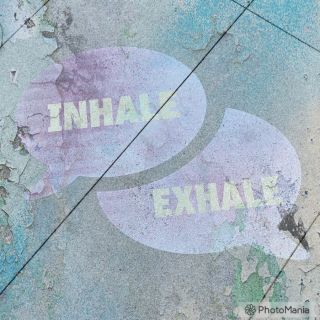Mindfulness
Small But Mighty Mindfulness Tactics, No. 1: Wheeze, Please
Basic breath meditation is a truly potent tactic. Teaching it is a must.
Updated June 30, 2023 Reviewed by Abigail Fagan
Key points
- Basic breath meditation is first and foremost of the "core four" brief meditation tactics.
- Basic breath practice is straightforward to teach to patients and students.
- The approach to offering this skill starts with some framing of benefits and attitudes, and demystification.

In the prior edition of the YMT blog (all hail acronyms!), I introduced some new content about educating our patients—and, first, ourselves—on brief but potent meditation tactics. These bite-sized reiterations of a mindfulness frame can provide a pop of present-moment awareness and immediate stress reduction.
Longer-form sitting meditation and other mindfulness practices are absolutely valid in cultivating a keener mind's eye and more facile adaptation to the ups and downs of contemporary life. While those practices could be metaphorically considered "vitamins," these tactics are more like "first aid"—easily employable around and in the midst of stressful events.
I've been gratified by the reader response (a ten-fold increase in a week from my usual posts), which may suggest a real need for practical skills and an affinity to culling them down to a "core four."
Let's focus on the first and foremost of the core four: basic breath meditation. I know... yawn. But its ubiquity as a helpful stress management exercise—from yoga, to Lamaze, to sitting at an endless red light—is just evidence of its benefit and portability. In terms of ready access to our breathing as a target, as I put pithily in Practical Mindfulness, "There's always a next one, or you’ve got bigger issues than this book will sufficiently address."
In the new book project on mindfulness in medicine I'm collaborating on, we categorize the many ways that breath meditation can be of aid in healthcare settings. The opportunities abound: office visits fit, "routine" but potentially provocative procedures like blood draws, pelvic exams, and prostate exams do too. Managing the litany of bizarre sonic events in an MRI machine (its gnomes with little jackhammers! Oh, now it's lunchtime at Chernobyl!) is easier with the breath as an interior phenomenon to attend to. And so on.

Basic breath meditation is not complex to learn or teach. There are many resources both for our own and our patients' training (here's one.) Yet as mindfulness still may represent an esoteric, frou-frou concept for some, and its training perceived as frustrating to do or even intruding on "spiritual" turf, I suggest first some personal familiarity with the practice so we can speak from experience regarding this helpful, secular tactic. Yes, we too can frou-frou, if we want to; and "poseur" healthcare professionals are easily outed.
With some experience in the, well, experience, we then may proceed with an educational invitation, framing succinctly how meditation helps. Before engaging in any final contracting about learning to meditate, an "attitude check" for the work is also important. Here's an example of the approach:
There's one really important aspect of meditation: the attitude we bring to it. Meditation goes best with an attitude of curiosity about how our minds work. An attitude of having to "get it right," or of critical judgment about how it's going, is not necessary. Actually, it's unhelpful.
It's more important to have some humility and even compassion for ourselves when it gets difficult, because that'll absolutely happen sometimes. So we try to let go of the judging, and instead just watch any judgment if or when it comes up. It's really just another thought to distract us, right?
An initial emphasis on keeping an open mind about opening the mind is usually helpful, even novel and liberating. At best, the attitude framing helps reinforce this practice as play, as exploration, with a dividend of calm and relief.
Then, we can ask (not demand, or shame into):
So… does this sound like something you'd like to try?
If some interest is clear, and some time available in the current visit (10 minutes as a minimum, so not always available for many busy outpatient schedules), we can launch there and then into some brief teaching. A short, shared, guided practice can be helpful to lower the bar to patients catching on.
We can try it right now, if that's OK.
We'll go for a minute or so. I'll meditate with you.
(You can use a smartphone timer, or the clock on the wall.)
Get comfortable but alert, like this.
(Sit up straight with both feet on the floor and hands on your knees, to model the physical position.)
Pick a spot on the floor to train your eyes on, or close them if you want.
Select a place to watch your breath—nose, throat, or belly. Watch yourself breathing in, then breathing out.
At some point, you will lose track of that. When you do, without fuss, go back to watching the in and out of breathing.
I'll let you know when we're halfway done. OK, let's start.
(It's helpful to model a couple of deep breaths; and a brief verbal reminder a few seconds in.)
When you lose track, it's OK—just go back to watching your breath.
(Let a minute, or whatever interval you suggested, elapse. Then, call time, and a quick check.)
"OK, time's up. So, what was that like? Did you notice anything? Feel any different?"
This not only reinforces our interest in the patient's experience, but also models a shared aspiration for that individual to notice as well.
Then what? Of course, practice should be encouraged, if only just a few minutes a day. A "When might this be helpful for you?" query, based on anticipated moments of stress, is a good idea also. For psychotherapy settings, some counselors build a brief, shared minute or two of breath meditation into the beginning (or end, or both) of a session, to set a tone of deliberate awareness.
So, wheeze, please; it can be a practical, powerfully effective skill. Next up: scanning exercises.
References
Sazima MD G. Practical Mindfulness: A Physician's No-Nonsense Guide to Meditation for Beginners. Mango Press, 2021.




